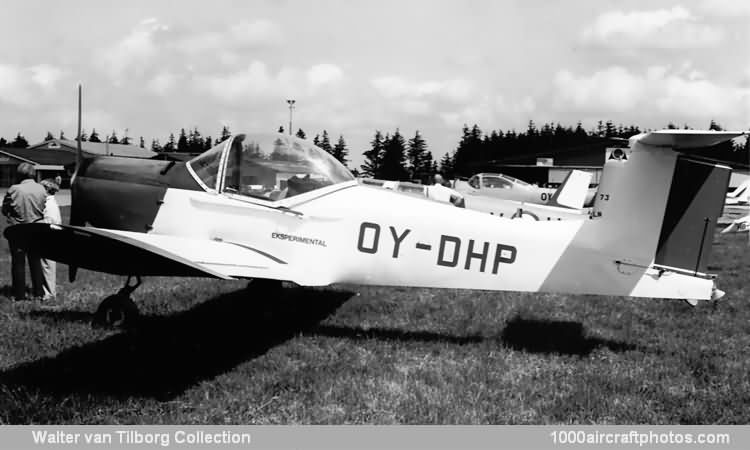The Polyt V was a minimum-weight single-seat prototype glider tug. The prototype was registered OY-DHP (c/n 12001) flew for the first time on April 12, 1970, construction having started in 1965. The structure was almost entirely of wood or glass fiber, with steel fittings. Suitability for agricultural duties, and the possibility of launching production, has been under consideration, but did not materialize. The prototype is still in use as a glider tug at the aero club of the Polyteknisk Flyvegruppe."
Wings: Cantilever low-wing monoplane. Wing section NACA 63-618 at root, NACA 63-218 at tip. Dihedral 4° from roots. Incidence 2°. No sweepback. Constant chord wooden box-spar structure, with plywood covering, except for leading edge covering of glass fiber. Wide-span plywood-covered plain wooden ailerons, each having a centrally-located trim tab. Inboard of each aileron is a mechanically-actuated air-brake/flap. These surfaces are carried on a shaft at 80% chord, the portion ahead of this shaft being perforated and the rear portion plain. Of aluminum construction, they have a maximum deflection of 50°; their use has no affect on lift or trim.
Fuselage: Plywood-covered wooden box structure.
Tail unit: Cantilever T-tail. All-wood structure, all surfaces plywood-covered. All-flying horizontal tail surface, with full-span tab. Trim tab in rudder.
Landing gear: Non-retractable tricycle type. Nose unit (leg, wheel and shock-absorber) from a Piper Colt, fitted with shimmy damper from a Cessna 172. Main gear legs formed by self-designed one-piece glass fiber unit, one-third arc of a circle of 6 ft 6.5 in (2.00 m) diameter, attached to underside of fuselage and providing both lateral and longitudinal shock-absorption. Cessna CFP 4097 main wheels, Piper nose wheel. All tires size 600 x 6, pressure 24 lb/sq.in (1.69 kg/sq.cm).
Power plant: One Lycoming IO-360-A2B four-cylinder horizontally-opposed air-cooled engine, rated at 200 hp at 2,700 rpm, driving either a Polyteknisk two-blade fixed-pitch wooden propeller or a Hoffmann
HO27-HM-205B-105 two-blade propeller. For cooling the engine during low-speed flight, a 21 in (53 cm) diameter fan with 16 plastic blades is mounted in the circular air intake behind the propeller and is capable of blowing some 3,500 cu.ft (99 cu.m) of air per minute – about four times the normal cooling flow. To prevent excessive cooling the under-nose cooling flap aft of the cowling closes automatically during a dive. Fuel in two aluminum tanks in the wings, total capacity 23.24 gal (88 l). Overwing refueling point in each tank. Oil capacity 1.98 gal (7.5 l).
Accommodation: Single seat for pilot under fully-transparent rearward-sliding canopy. Cockpit heated and ventilated.
Systems: Electrical system includes AC alternator and 12V battery for engine starting, instruments, lights and towing winch. Vacuum pump for directional gyro.
Electronics and equipment: Radio for communication with glider only. Equipment includes an electrically-operated winch in the rear fuselage, which can reel in over 130 ft (ca. 40 m) of nylon tow line in 40 sec after sailplane is released. Aircraft can make seven or eight launches an hour.
